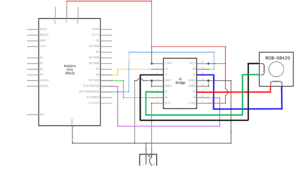Step 1: Build the circuit
Materials:
1 * 42STH33-0404AC stepper motor
1 * L293D ic chip
1 * power jack
1 * 12 VDC power supply
1 * Arduino kit and its contents
The most important part here (also in most recitation projects), is to be as careful as possible. 
For a chart as complex as this one, it is better that we read through the lines and have an overall idea of what to do next. Another crucial part is to color-code the lines. In fact, I realized that at the beginning, but I was confident with my carefulness so I chose the cables arbitrarily, which not only confused the instructors, but also caused great trouble to my double-check.
One other thing to remember is to plug in the feet of the electric components! This happened twice, that I was not “brave” enough to push in the feet and therefore the circuit did not work.
Finally, after the two problems were solved, my motor worked.
Step 2: Control rotation with a potentiometer
Materials: Same as step 1
This was the second time that I didn’t push in the feet of the components hard. I have to remember this! For mistakes like this rather than some fundamental mistake can be really upsetting.
Step 3: Build a Drawing Machine!
Materials:
2 * Laser-cut short arms
2 * Laser-cut long arms
1* Laser-cut motor holder
2 * 3D printed motor coupling
5 * Paper Fasteners
1 * Pen that fits the laser-cut mechanisms
Paper
Everything went smoothly, but I was upset that we couldn’t draw a painting that makes sense.
Also, there was something wrong with my partner’s circuit, for her motor was moving automatically, but we didn’t have time to figure that out.
Question 1:What kind of machines would you be interested in building? Add a reflection about the use of actuators, the digital manipulation of art, and the creative process to your blog post.
I want to build a “smell recorder”. I go to and back from school by bikes, and everytime I ride pass the osmanthus trees, I feel soothing and upset at the same time for I can’t keep the smell. The machine can contain a certain amount of chemical elements such as arene. When you record a smell, the proportion of each type of chemical molecule is tested, and the next time you want to smell that fragrence again, the molecules would be released calculatively. The actuators would be chemicals. The sense of art here, I think, is the idea to keep asthetic things in life.
Question 2:
The choice of actuator partly depends on whether the input would be analog or digital. For example, in Daniel Rozin’s Wooden Mirror, the actuators are little wood blocks. The choice of this depends largely on the fact that the input is an “yes” or “no” question. For an image is broken down into millions of units, each of which is black or white (or 1 or 0). Therefore, wooden block is an ideal actuator.
With regard to our drawing machine, for it is continuing lines that we want for output, we need devices that can answer more than “yes or no” questions. Therefore, the motors are used.